 CLOUD
CLOUD
 CLOUD
CLOUD
 CLOUD
CLOUD
As we exited the isolation economy last year, we introduced supercloud as a term to describe something new that was happening in the world of cloud computing.
In this Breaking Analysis, we address the ten most frequently asked questions we get on supercloud. Today we’ll address the following frequently asked questions:
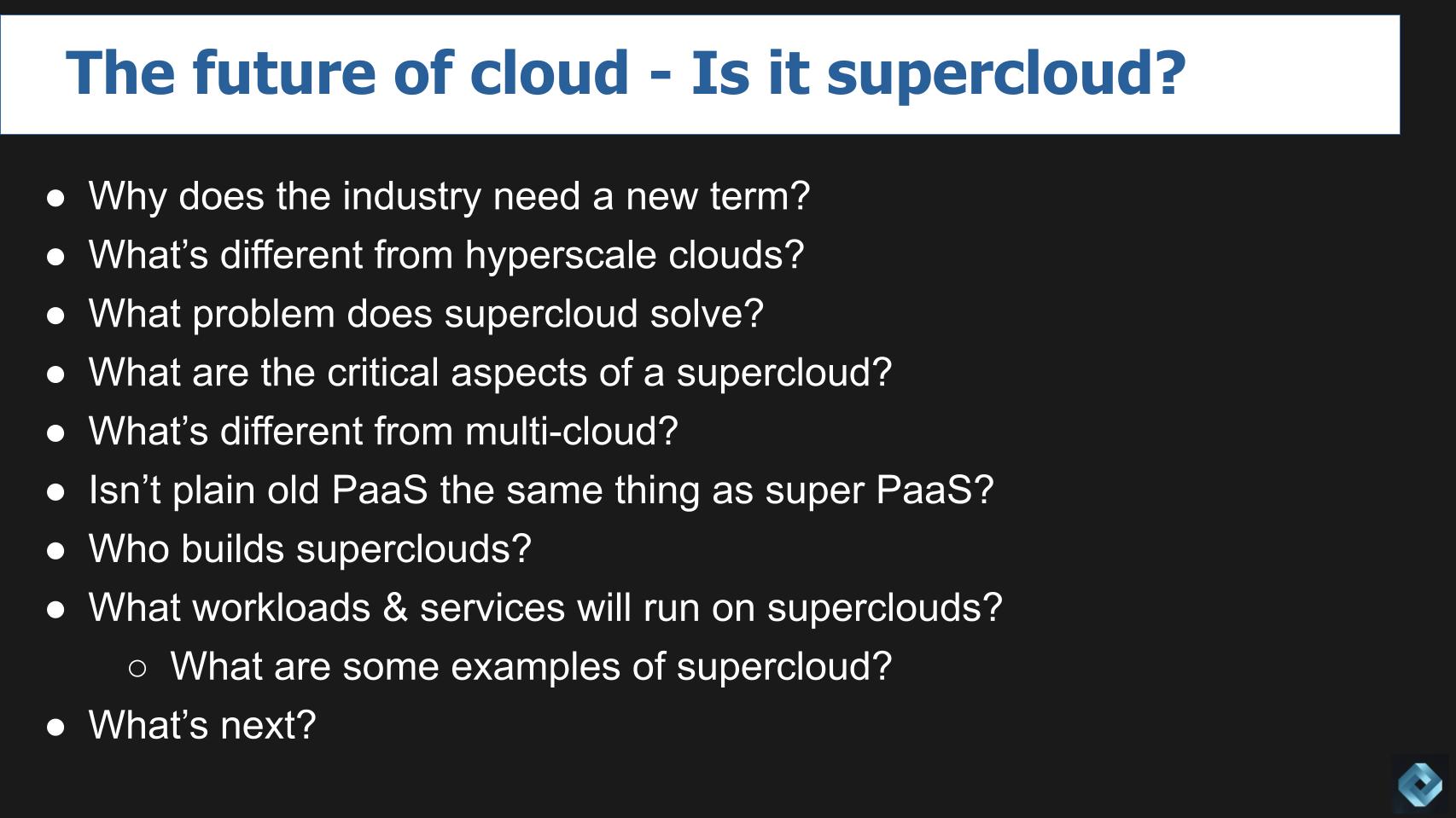
1. In an industry full of hype and buzzwords, why does anyone need a new term?
2. Aren’t hyperscalers building out superclouds? We’ll try to answer why the term supercloud connotes something different from a hyperscale cloud.
3. We’ll talk about the problems superclouds solve.
4. We’ll further define the critical aspects of a supercloud architecture.
5. We often get asked: Isn’t this just multicloud? Well, we don’t think so and we’ll explain why.
6. In an earlier episode we introduced the notion of superPaaS – well, isn’t a plain vanilla PaaS already a superPaaS? Again – we don’t think so and we’ll explain why.
7. Who will actually build (and who are the players currently building) superclouds?
8. What workloads and services will run on superclouds?
9. What are some examples of supercloud?
10. Finally, we’ll answer what you can expect next on supercloud from SiliconANGLE and theCUBE.

Late last year, ahead of Amazon Web Services Inc.’s re:Invent conference, we were inspired by a post from Jerry Chen called Castles in the Cloud. In that blog he introduced the idea that there were submarkets emerging in cloud that presented opportunities for investors and entrepreneurs, that the big cloud vendors weren’t going to suck all the value out of the industry. And so we introduced this notion of supercloud to describe what we saw as a value layer emerging above the hyperscalers’ “capex gift.”
It turns out that we weren’t the only ones using the term, as both Cornell and MIT have used the phrase in somewhat similar but different contexts.
The point is something new was happening in the AWS and other ecosystems. It was more than infrastructure as a service and platform as a service and wasn’t just software as a service running in the cloud.
It was a new architecture that integrates infrastructure, unique platform attributes and software to solve new problems that the cloud vendors in our view weren’t addressing by themselves. It seemed to us that the ecosystem was pursuing opportunities across clouds that went beyond conventional implementations of multi-cloud.
In addition, we felt this trend pointed to structural change going on at the industry level that supercloud metaphorically was highlighting.
So that’s the background on why we felt a new catchphrase was warranted. Love it or hate it… it’s memorable.
To that last point about structural industry transformation: Andy Rappaport is sometimes credited with identifying the shift from the vertically integrated mainframe era to the horizontally fragmented personal computer- and microprocessor-based era in his Harvard Business Review article from 1991.
In fact, it was actually David Moschella, an International Data Corp. senior vice president at the time, who introduced the concept in 1987, a full four years before Rappaport’s article was published. Moschella, along with IDC’s head of research Will Zachmann, saw that it was clear Intel Corp., Microsoft Corp., Seagate Technology and other would replace the system vendors’ dominance.
In fact, Zachmann accurately predicted in the late 1980s the demise of IBM, well ahead of its epic downfall when the company lost approximately 75% of its value. At an IDC Briefing Session (now called Directions), Moschella put forth a graphic that looked similar to the first two concepts on the chart below.
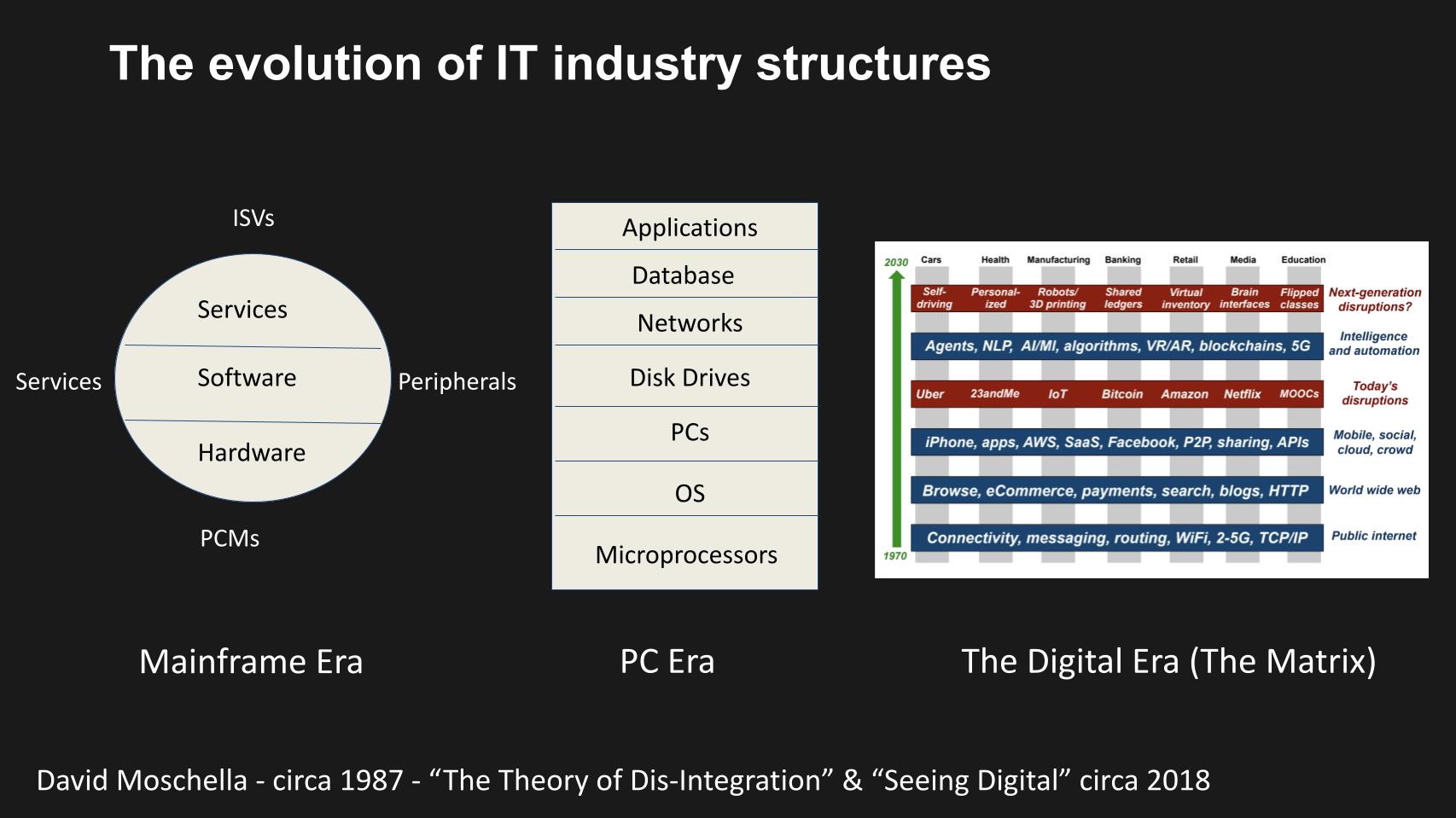
We don’t have to review the shift from IBM as the epicenter of the industry to Wintel – that’s well-understood.
What isn’t as widely discussed is a structural concept Moschella put out in 2018 in his book “Seeing Digital,” which introduced the idea of the Matrix shown on the righthand side of this chart. Moschella posited that a new digital platform of services was emerging built on top of the internet, hyperscale clouds and other intelligent technologies that would define the next era of computing.
He used the term matrix because the conceptual depiction included horizontal technology rows, like the cloud… but for the first time included connected industry columns. Moschella pointed out that historically, industry verticals had a closed value chain or stack of research and development, production, distribution, etc., and that expertise in that specific vertical was critical to success. But now, because of digital and data, for the first time, companies were able to jump industries and compete using data. Amazon in content, payments and groceries… Apple in payments and content… and so forth. Data was now the unifying enabler and this marked a changing structure of the technology landscape.
So the term supercloud is meant to imply more than running in hyperscale clouds. Rather, it’s a new type of digital platform comprising a combination of multiple technologies – enabled by cloud scale – with new industry participants from financial services, healthcare, manufacturing, energy, media and virtually all industries. Think of it as kind of an extension of “every company is a software company.”
Basically, thanks to the cloud, every company in every industry now has the opportunity to build their own supercloud. We’ll come back to that.
Let’s address what’s different about superclouds relative to hyperscale clouds.
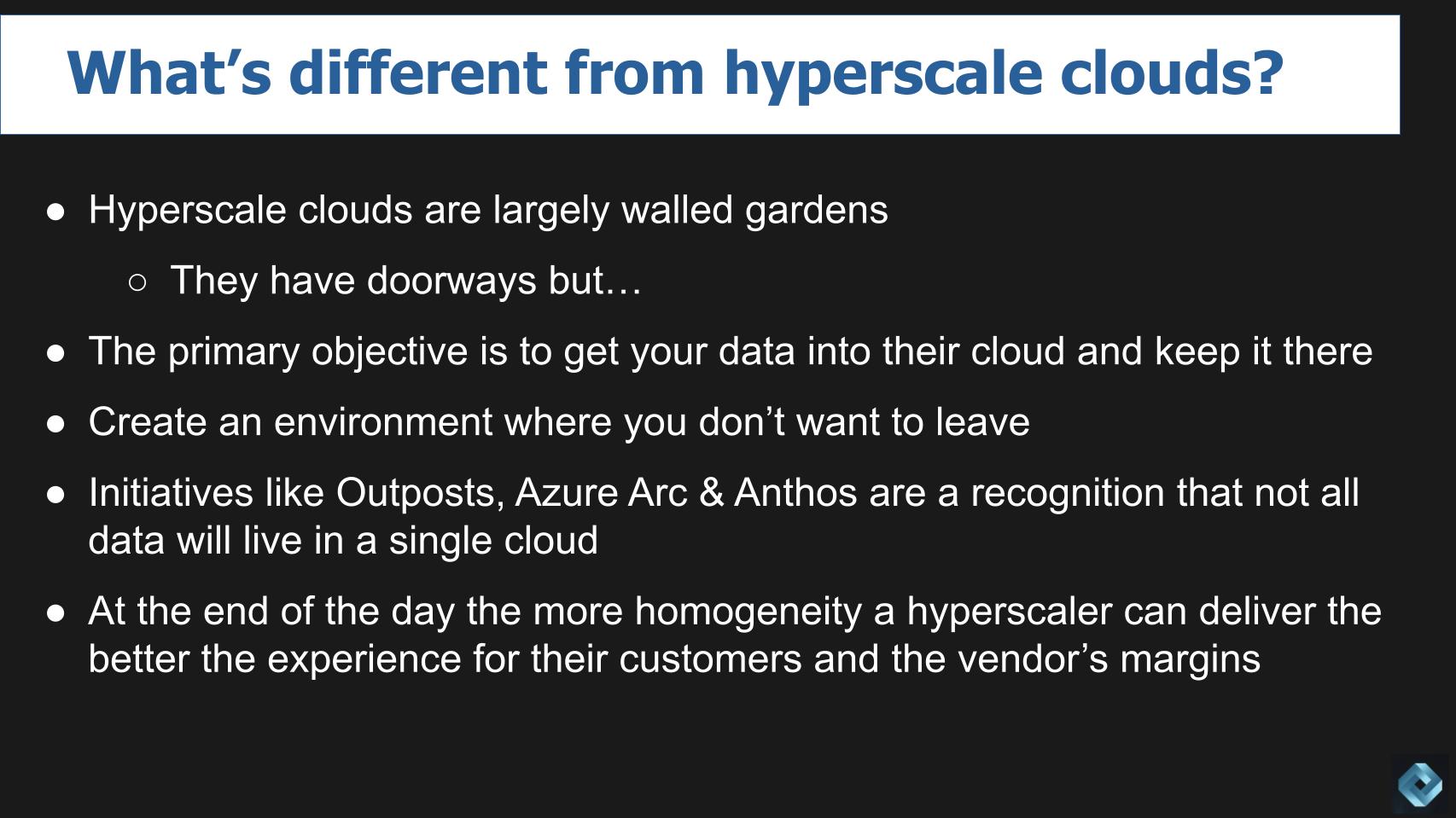
This one’s pretty straightforward and obvious. Hyperscale clouds are walled gardens where they want your data in their cloud and they want to keep you there. Sure, every cloud player realizes that not all data will go to their cloud, so they’re meeting customers where their data lives with initiatives such Amazon Outposts and Azure Arc and Google Anthos. But at the end of the day, the more homogeneous they can make their environments, the better control, security, costs and performance they can deliver. The more complex the environment, the more difficult to deliver on their promises and the less margin left for them to capture.
Will the hyperscalers get more serious about cross cloud services? Maybe, but they have plenty of work to do within their own clouds. And today at least they appear to be providing the tools that will enable others to build superclouds on top of their platforms. That said, we never say never when it comes to companies such as AWS. And for sure we see AWS delivering more integrated digital services such as Amazon Connect to solve problems in a specific domain, call centers in this case.
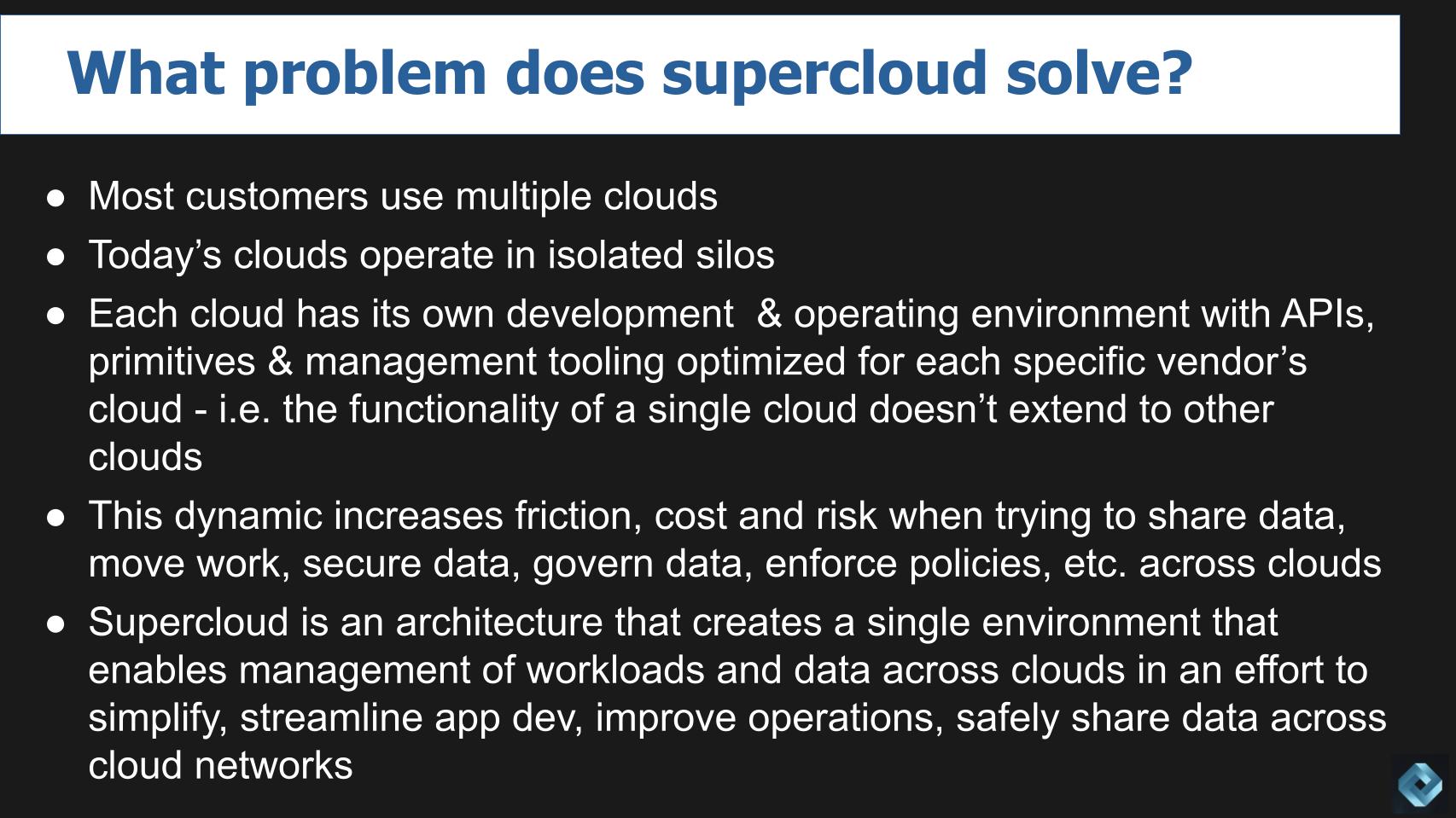
We’ve all seen the stats from IDC or Gartner or whomever that customers on average use more than one cloud. And we know these clouds operate in disconnected silos for the most part. That’s a problem because each cloud requires different skills. The development environment is different, as is the operating environment, with different APIs and primitives and management tools that are optimized for each respective hyperscale cloud. Their functions and value props don’t extend to their competitors’ clouds. Why would they?
As a result, there’s friction when moving between different clouds. It’s hard to share data, move work, secure and govern data, and enforce organizational policies and edicts across clouds.
Supercloud is an architecture designed to create a single environment that enables management of workloads and data across clouds in an effort to take out complexity, accelerate application development, streamline operations and share data safely irrespective of location.
Pretty straightforward, but nontrivial, which is why we often ask company chief executives and execs if stock buybacks and dividends will yield as much return as building out superclouds that solve really specific problems and create differentiable value for their firms.
Let’s dig in a bit more to the architectural aspects of supercloud. In other words… what are the salient attributes that define supercloud?
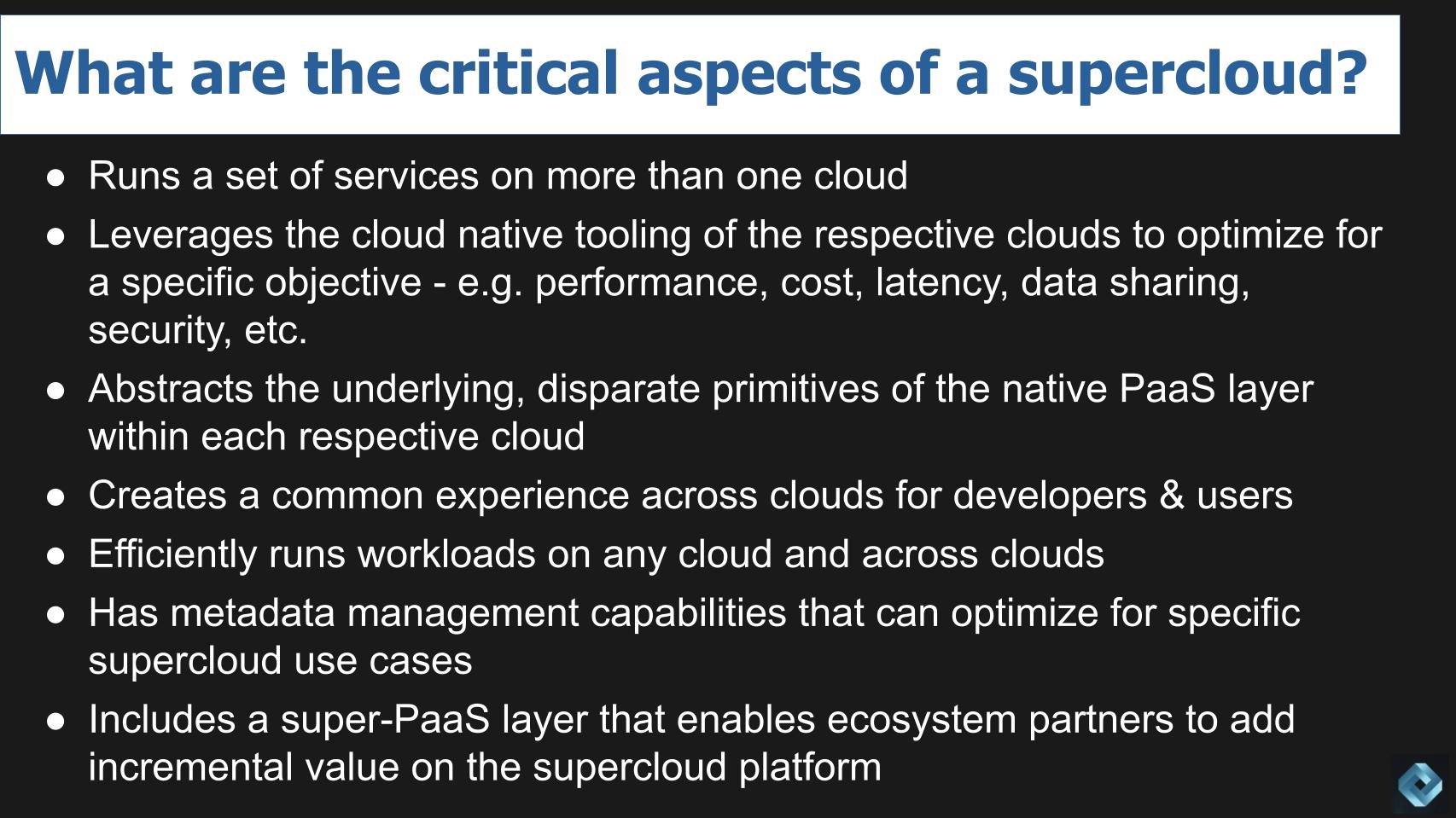
First, a supercloud runs a set of specific services, designed to solve a unique problem. Superclouds offer seamless, consumption-based services across multiple distributed clouds.
Supercloud leverages the underlying cloud-native tooling of a hyperscale cloud but it’s optimized for a specific objective that aligns with the problem it’s solving. For example, it may be optimized for cost or low latency or sharing data or governance or security or higher performance networking. But the point is, the collection of services delivered is focused on unique value that isn’t being delivered by the hyperscalers across clouds.
A supercloud abstracts the underlying and siloed primitives of the native PaaS layer from the hyperscale cloud and using its own specific platform-as-a-service tooling, creates a common experience across clouds for developers and users. In other words, the superPaaS ensures that the developer and user experience is identical, irrespective of which cloud or location is running the workload.
And it does so in an efficient manner, meaning it has the metadata knowledge and management that can optimize for latency, bandwidth, recovery, data sovereignty or whatever unique value the supercloud is delivering for the specific use cases in the domain.
A supercloud comprises a superPaaS capability that allows ecosystem partners to add incremental value on top of the supercloud platform to fill gaps, accelerate features and innovate. A superPaaS can use open tooling but applies those development tools to create a unique and specific experience supporting the design objectives of the supercloud.
Supercloud services can be infrastructure-related, application services, data services, security services, users services, etc., designed and packaged to bring unique value to customers… again that the hyperscalers are not delivering across clouds or on-premises.
Finally, these attributes are highly automated where possible. Superclouds take a page from hyperscalers in terms of minimizing human intervention wherever possible, applying automation to the specific problem they’re solving.
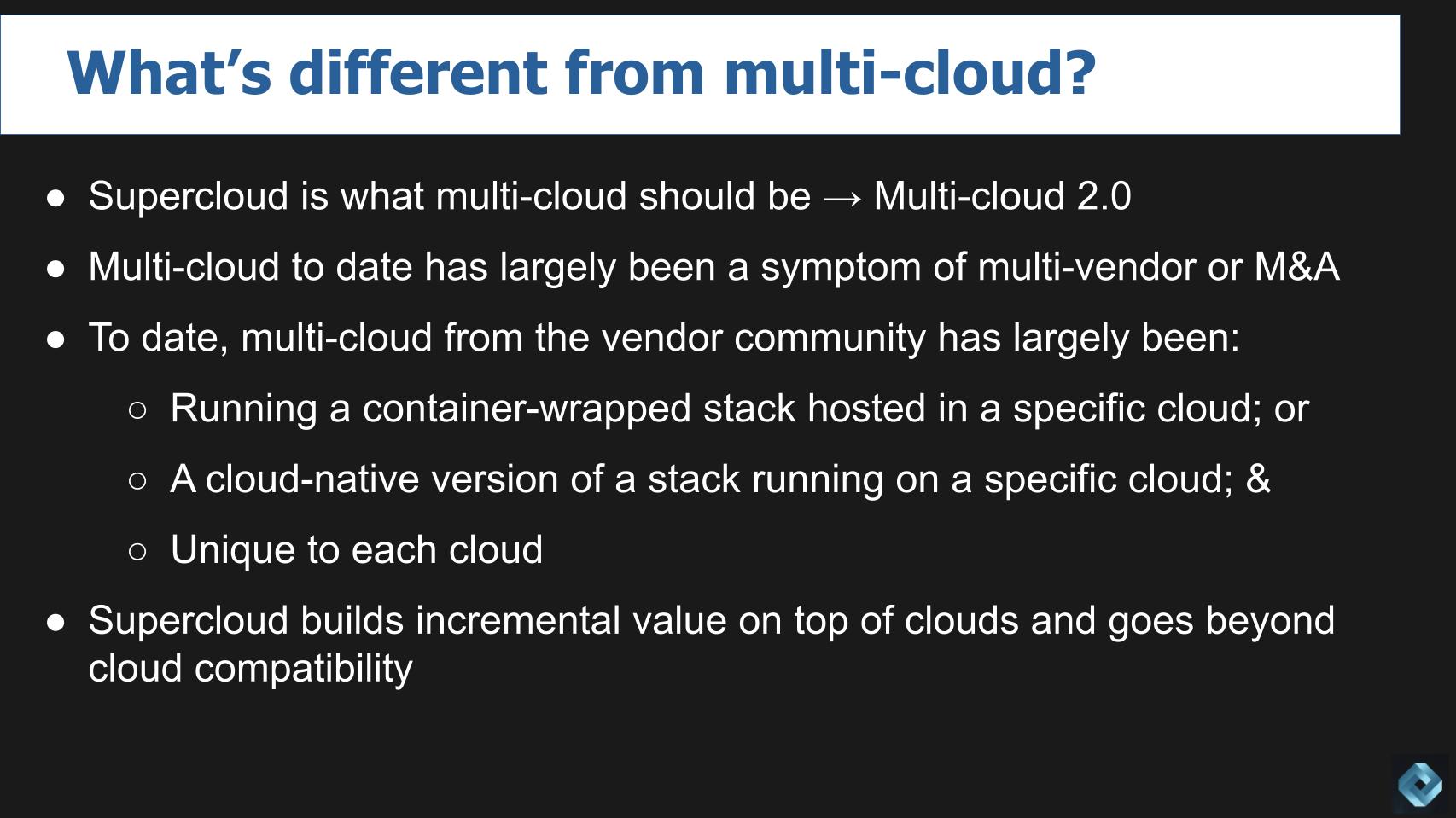
What we’d say to that is: Perhaps, but not really. Call it multicloud 2.0 if you want to invoke a commonly used format. But as Dell’s Chuck Whitten proclaimed, multicloud by design is different than multicloud by default.
What he means is that, to date, multicloud has largely been a symptom of multivendor… or of M&A. And when you look at most so-called multicloud implementations, you see things like an on-prem stack wrapped in a container and hosted on a specific cloud.
Or increasingly a technology vendor has done the work of building a cloud-native version of its stack and running it on a specific cloud… but historically it has been a unique experience within each cloud with no connection between the cloud silos. And certainly not a common developer experience with metadata management across clouds.
Supercloud sets out to build incremental value across clouds and above hyperscale capex that goes beyond cloud compatibility within each cloud. So if you want to call it multicloud 2.0, that’s fine.
We choose to call it supercloud.
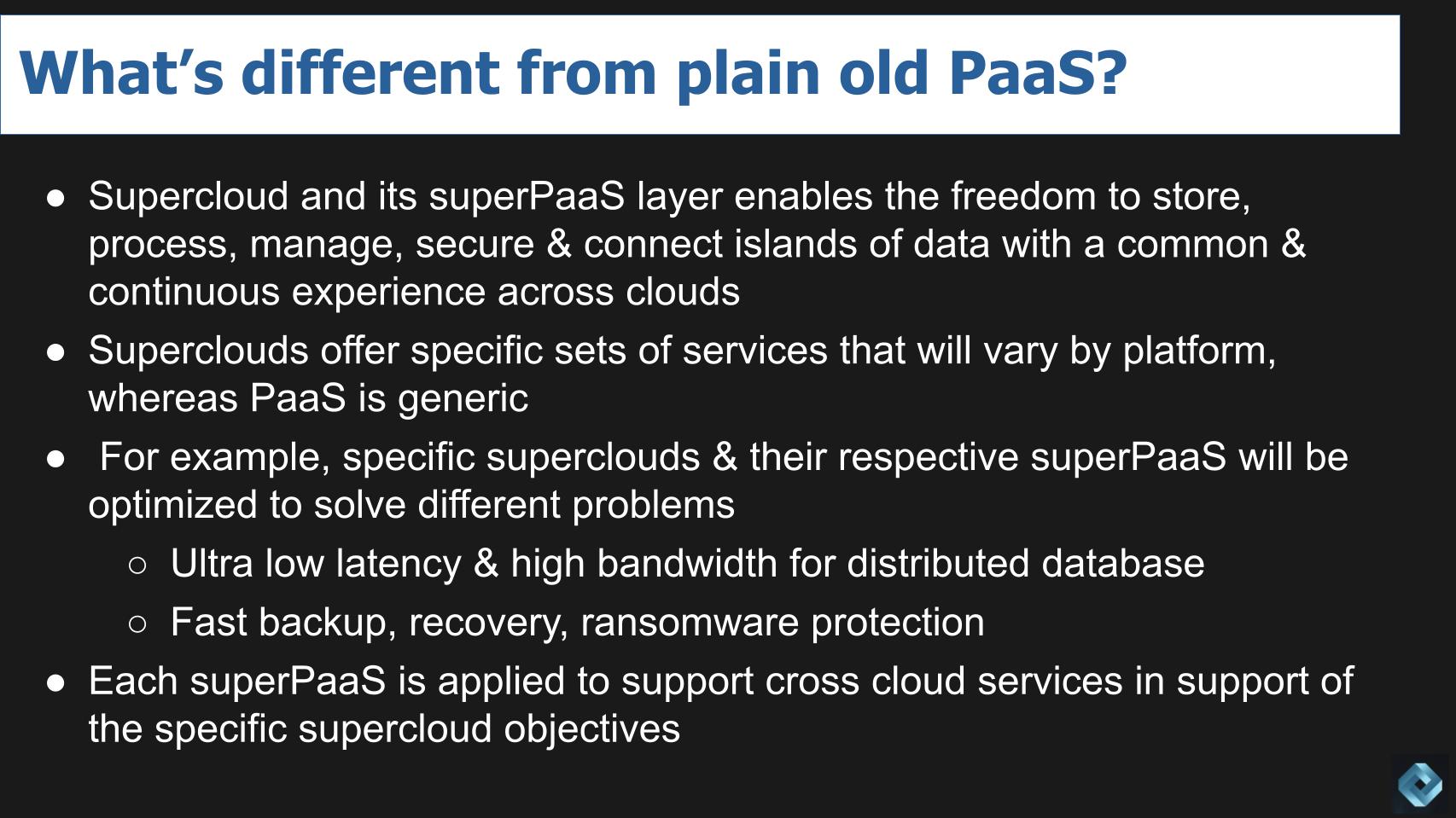
Well, we’d say no. That supercloud and its corresponding superPaaS layer gives the freedom to store, process, manage, secure and connect islands of data across a continuum with a common developer experience across clouds.
Importantly, the sets of services are designed to support the supercloud’s objectives – e.g., data sharing or data protection or storage and retrieval or cost optimization or ultra-low latency, etc. In other words, the services offered are specific to that supercloud and will vary by each offering. OpenShift, for example, can be used to construct a superPaaS but in and of itself isn’t a superPaaS. It’s generic.
The point is that a supercloud and its inherent superPaaS will be optimized to solve specific problems such as low latency for distributed databases or fast backup and recovery and ransomware protection — highly specific use cases that the supercloud is designed to solve for.
SaaS as well is a subset of supercloud. Most SaaS platforms either run in their own cloud or have bits and pieces running in public clouds (e.g. analytics). But the cross-cloud services are few and far between or often nonexistent. We believe SaaS vendors must evolve and adopt supercloud to offer distributed solutions across cloud platforms and stretching out to the near and far edge.
Another question we often get is: Who has a supercloud and who is building a supercloud? Who are the contenders?
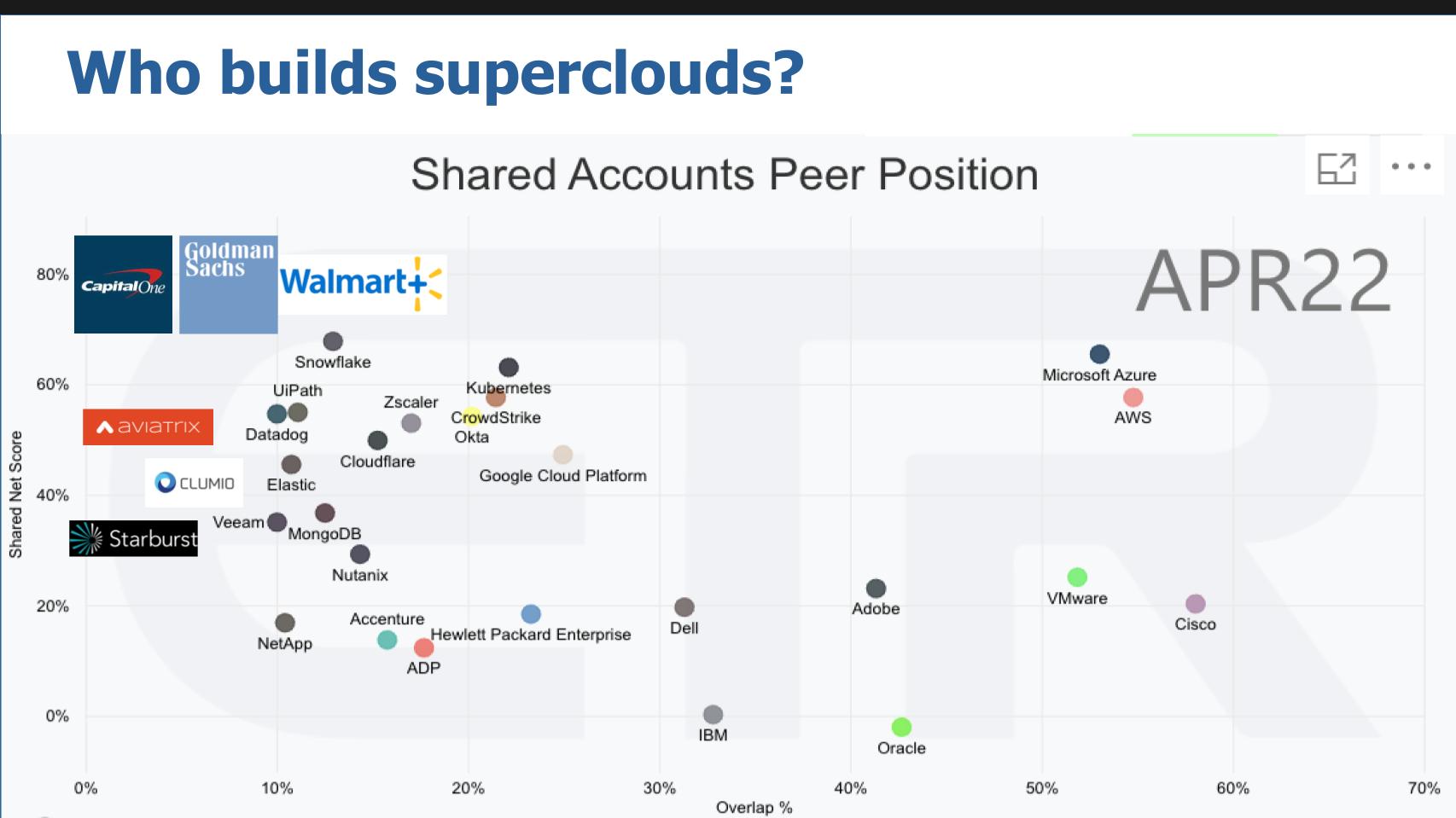
Well, most companies that consider themselves cloud players will, we believe, be building superclouds. Above is a common Enterprise Technology Research graphic we like to show with Net Score or spending momentum on the Y axis and Overlap or pervasiveness in the ETR surveys on the X axis. This is from the April survey of well over 1,000 chief executive officers and information technology buyers. And we’ve randomly chosen a number of players we think are in the supercloud mix and we’ve included the hyperscalers because they are the enablers.
We’ve added some of those nontraditional industry players we see building superclouds such as Capital One, Goldman Sachs and Walmart, in deference to Moschella’s observation about verticals. This goes back to every company being a software company. And rather than pattern-matching an outdated SaaS model we see a new industry structure emerging where software and data and tools specific to an industry will lead the next wave of innovation via the buildout of intelligent digital platforms.
We’ve talked a lot about Snowflake Inc.’s Data Cloud as an example of supercloud, as well as the momentum of Databricks Inc. (not shown above). VMware Inc. is clearly going after cross-cloud services. Basically every large company we see is either pursuing supercloud initiatives or thinking about it. Dell Technologies Inc., for example, showed Project Alpine at Dell Technologies World – that’s a supercloud in development. Snowflake introducing a new app dev capability based on its SuperPaaS (our term, of course, it doesn’t use the phrase), MongoDB Inc., Couchbase Inc., Nutanix Inc., Veeam Software, CrowdStrike Holdings Inc., Okta Inc. and Zscaler Inc. Even the likes of Cisco Systems Inc. and Hewlett Packard Enterprise Co., in our view, will be building superclouds.
Although ironically, as an aside, Fidelma Russo, HPE’s chief technology officer, said on theCUBE she wasn’t a fan of cloaking mechanisms. But when we spoke to HPE’s head of storage services, Omer Asad, we felt his team is clearly headed in a direction that we would consider supercloud. It could be semantics or it could be that parts of HPE are in a better position to execute on supercloud. Storage is an obvious starting point. The same can be said of Dell.
Listen to Fidelma Russo explain her aversion to building a manager of managers.
And we’re seeing emerging companies like Aviatrix Systems Inc. (network performance), Starburst Data Inc. (self-service analytics for distributed data), Clumio Inc. (data protection – not supercloud today but working on it) and others building versions of superclouds that solve a specific problem for their customers. And we’ve spoken to independent software vendors such as Adobe Systems Inc., Automatic Data Processing LLC and UiPath Inc., which are all looking at new ways to go beyond the SaaS model and add value within cloud ecosystems, in particular building data services that are unique to their value proposition and will run across clouds.
So yeah – pretty much every tech vendor with any size or momentum and new industry players are coming out of hiding and competing… building superclouds. Many that look a lot like Moschella’s matrix with machine intelligence and artificial intelligence and blockchains and virtual reality and gaming… all enabled by the internet and hyperscale clouds.
It’s moving fast and it’s the future, in our opinion, so don’t get too caught up in the past or you’ll be left behind.
We’ve given many in the past, but let’s try to be a bit more specific. Below we cite a few and we’ll answer two questions in one section here: What workloads and services will run in superclouds and what are some examples?
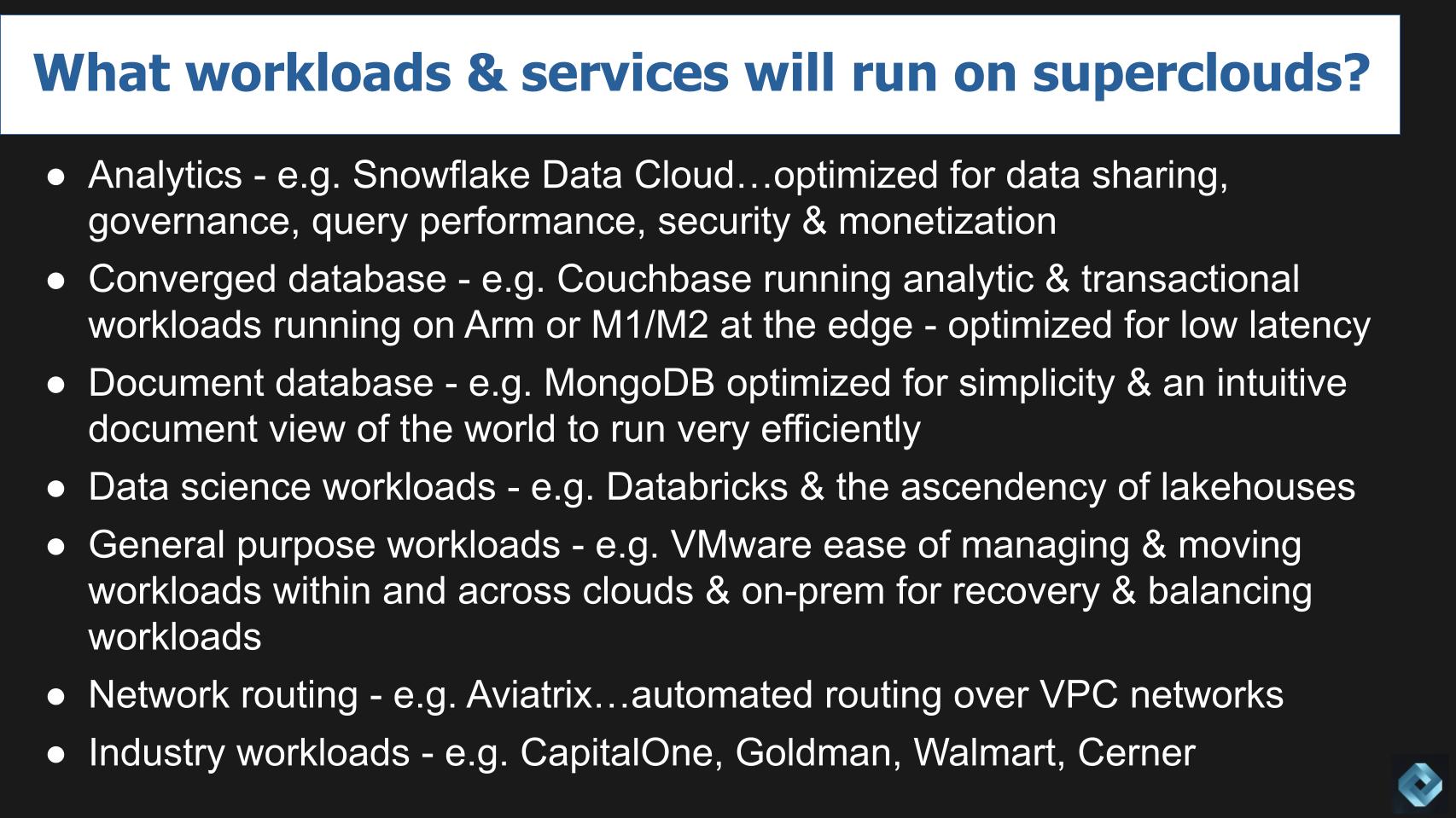
Analytics. Snowflake is the furthest along with its data cloud in our view. It’s a supercloud optimized for data sharing, governance, query performance, security, ecosystem enablement and ultimately monetization. Snowflake is now bringing in new data types and open-source tooling and it ticks the attribute boxes on supercloud we laid out earlier.
Converged databases. Running transaction and analytics workloads. Take a look at what Couchbase is doing with Capella and how it’s enabling stretching the cloud to the edge with Arm-based platforms and optimizing for low latency across clouds and out to the edge.
Document database workloads. Look at MongoDB – a developer-friendly platform that with Atlas is moving to a supercloud model running document databases very efficiently. Accommodating analytic workloads and creating a common developer experience across clouds.
Data science workloads. For example, Databricks is bringing a common experience for data scientists and data engineers driving machine intelligence into applications and fixing the broken data lake with the emergence of the lakehouse.
General-purpose workloads. For example, VMware’s domain. Very clearly there’s a need to create a common operating environment across clouds and on-prem and out to the edge and VMware is hard at work on that — managing and moving workloads, balancing workloads and being able to recover very quickly across clouds.
Network routing. This is the primary focus of Aviatrix, building what we consider a supercloud and optimizing network performance and automating security across clouds.
Industry-specific workloads. For example, Capital One announcing its cost optimization platform for Snowflake – piggybacking on Snowflake’s supercloud. We believe it’s going to test that concept outside its own organization and expand across other clouds as Snowflake grows its business beyond AWS. Walmart Inc. is working with Microsoft to create an on-prem to Azure experience – yes, that counts. We’ve written about what Goldman is doing and you can bet dollars to donuts that Oracle Corp. will be building a supercloud in healthcare with its Cerner acquisition.
Supercloud is everywhere you look. Sorry, naysayers. It’s happening.
With all the industry buzz and debate about the future, John Furrier and the team at SiliconANGLE have decided to host an event on supercloud. We’re motivated and inspired to further the conversation. TheCUBE on Supercloud is coming.
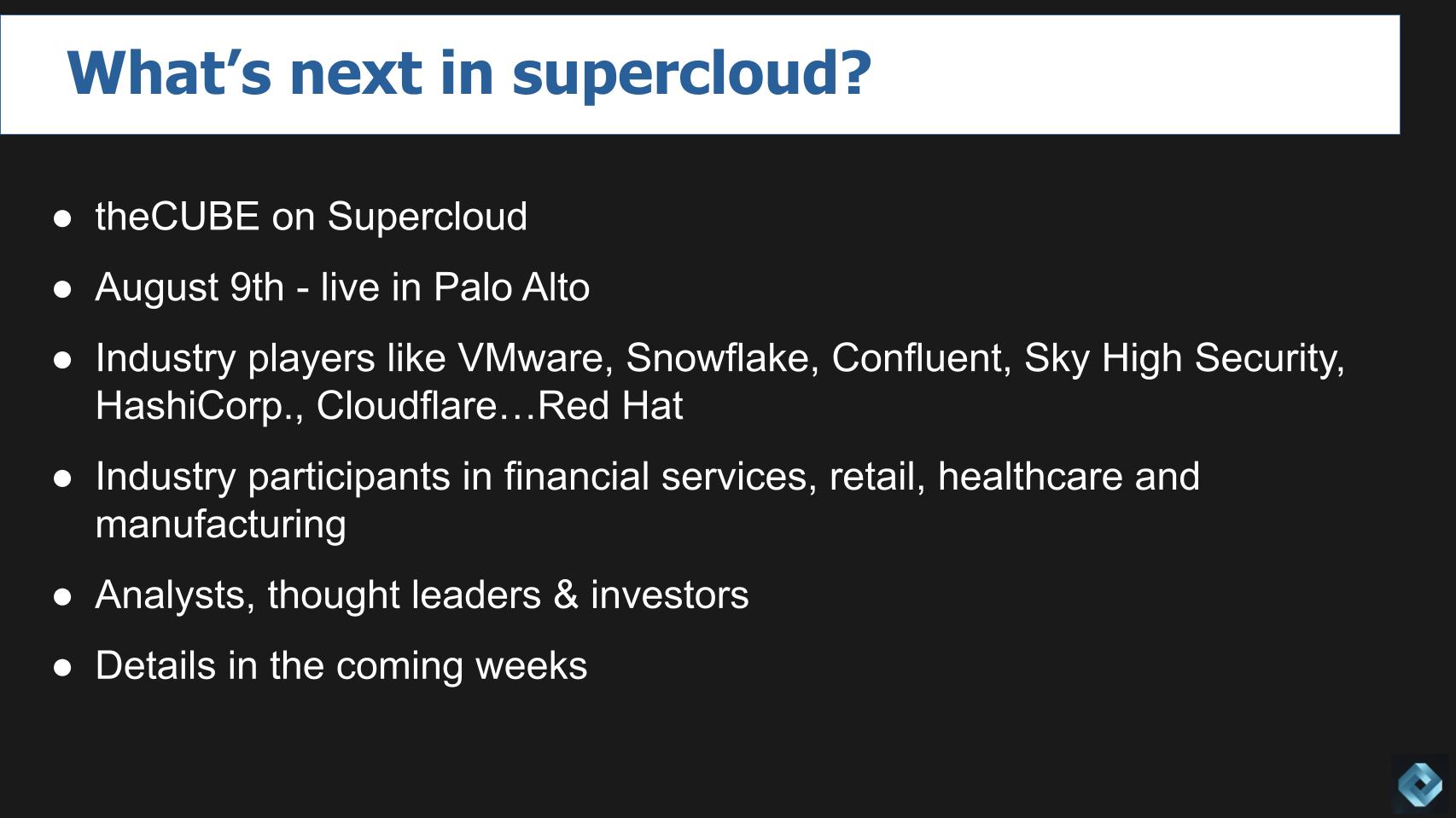
On Aug. 9 out of our Palo Alto studios we’ll be running a live program on the topic. We’ve reached out to a number of industry participants — VMware, Snowflake, Confluent, Sky High Security, Hashicorp, Cloudflare and Red Hat — to get the perspective of technologists building superclouds.
And we’ve invited a number of vertical industry participants in financial services, healthcare and retail that we’re excited to have on along with analysts, thought leaders and investors.
We’ll have more details in the coming weeks, but for now if you’re interested please reach out to us with how you think you can advance the discussion and we’ll see if we can fit you in.
So mark your calendars and stay tuned for more information.
Thanks to Alex Myerson, who does the production, podcasts and media workflows for Breaking Analysis. Special thanks to Kristen Martin and Cheryl Knight, who help us keep our community informed and get the word out, and to Rob Hof, our editor in chief at SiliconANGLE.
Remember we publish each week on Wikibon and SiliconANGLE. These episodes are all available as podcasts wherever you listen.
Email david.vellante@siliconangle.com, DM @dvellante on Twitter and comment on our LinkedIn posts.
Also, check out this ETR Tutorial we created, which explains the spending methodology in more detail. Note: ETR is a separate company from Wikibon and SiliconANGLE. If you would like to cite or republish any of the company’s data, or inquire about its services, please contact ETR at legal@etr.ai.
Here’s the full video analysis:
All statements made regarding companies or securities are strictly beliefs, points of view and opinions held by SiliconANGLE media, Enterprise Technology Research, other guests on theCUBE and guest writers. Such statements are not recommendations by these individuals to buy, sell or hold any security. The content presented does not constitute investment advice and should not be used as the basis for any investment decision. You and only you are responsible for your investment decisions.
Disclosure: Many of the companies cited in Breaking Analysis are sponsors of theCUBE and/or clients of Wikibon. None of these firms or other companies have any editorial control over or advanced viewing of what’s published in Breaking Analysis.
THANK YOU